2. 中国石油四川石化有限责任公司, 成都 611930;
3. 环境保护部华南环境科学研究所, 广州 510655
2. PetroChina Sichuan Petrochemical Company Limited, Chengdu 611930, China;
3. South China Institute of Environmental Sciences, Ministry of Environmental Protection, Guangzhou 510655, China
二噁英是多氯二苯并二噁英和多氯二苯并呋喃(PCDD/Fs)的统称, PCDD/Fs具有极强的毒性, 其中2, 3, 7, 8-TCDD毒性最大, 是人们无意识合成的毒性最强的化合物之一[1], 对人体健康危害极大, 具有极强的致癌性、致畸性和致突变性等[2, 3].
在垃圾焚烧过程中, 由于高温、有机物的不完全燃烧、金属物质的催化等作用, 为二噁英类物质生成提供了最佳环境条件, 因此垃圾焚烧成为二噁英类污染物质排放的主要来源之一[4].根据美国国家科学院推荐的评估方法, 比利时、西班牙、中国台湾等国家和地区[5~7]先后对城市垃圾焚烧厂排放烟气进行人体健康风险评估发现, 人们对二噁英的暴露风险主要来自食物的消化吸收、呼吸空气或颗粒物、皮肤接触污染.而对于在垃圾焚烧行业环境内工作的人群, 呼吸是人体暴露的主要途径, 虽然接触时间不长, 但单位时间内暴露剂量相对较大[8], 造成较高的健康风险.我国人体暴露与风险评价的相关研究与工作相对于其他国家起步较晚, 尚处于探索阶段, 大多是对污水处理厂、采矿区、核工业等重大污染场地进行重金属和无机物的健康风险评价[9], 对于垃圾焚烧厂区相关研究甚少.
有研究表明, 焚烧炉类型、环境介质及所处地区等是影响二噁英浓度水平及分布特征的重要因素[10~14].我国垃圾焚烧厂焚烧炉类型主要为炉排炉和流化床[15], 因此本文以国内两大类型垃圾焚烧厂(A厂焚烧炉类型为炉排炉, B厂焚烧炉类型为循环流化床)为研究对象, 通过采集厂区活动场所环境空气样品, 分析样品中的二噁英类物质污染水平及其分布特征, 评估职业工人二噁英呼吸暴露风险情况, 以期为我国职业场所的二噁英污染水平及健康危害等相关研究提供基础数据, 并为改善相关工人工作环境、建立作业环境监控等方面提供科学依据.
1 材料与方法 1.1 仪器与试剂 1.1.1 实验仪器高分辨率气相色谱-高分辨率质谱联用仪(HRGC-HRMS, Agilent 6890, Waters AutoSpec Primer); 旋转蒸发仪(R-215型, 瑞士Buchi公司); MGS氮吹仪(MG-2200型, 日本Eyela公司); 真空干燥器(Vacucenter VC50型, 瑞士SalvisLAB公司); 大流量环境空气采样器(Tecora, TCR, 意大利).其中, HRGC-HRMS选用型号为DB-5MS(60 m×0.25 mm×0.25 μm)的硅熔毛细管柱, 进样口温度为280℃, 进样量为1 μL, 不分流, 升温程序为140℃, 保持2 min再以8.0℃·min-1的速率上升至220℃然后以1.4℃·min-1的速率升高到310℃, 保持5 min; 高分辨率质谱仪的分辨率高于10 000, EI离子源, 离子源温度为300℃, 加速电压为7 900 V, 电子能量为35 eV.
1.1.2 实验试剂PCDD/Fs标样:Cambridge Isotope Laboratory; 中性硅胶:高纯度, 德国Merk公司; 弗罗里硅酸镁:德国Riedel_de Haën公司; 甲醇、丙酮、二氯甲烷、甲苯和正己烷:农残级, 美国Honeywell公司; 玻璃纤维滤膜(Glass Fiber Filter, GFF, 20.3 cm×25.4 cm):瑞典Munktell公司.
1.2 样品采集研究所选焚烧厂基本概况见表 1, 采样点分布见图 1.采样点(A1~A4、B1~B4) 分别于两厂厂区内宿舍区、办公区、中控室及主厂房焚烧炉后; 在采样季节该区域主导风向为东南风; 将该区域内无明显二噁英贡献源的地点设为背景对照区, 共两个采样点(C1、C2).
|
|
表 1 垃圾焚烧厂基本情况 Table 1 Waste incineration plant specifications |
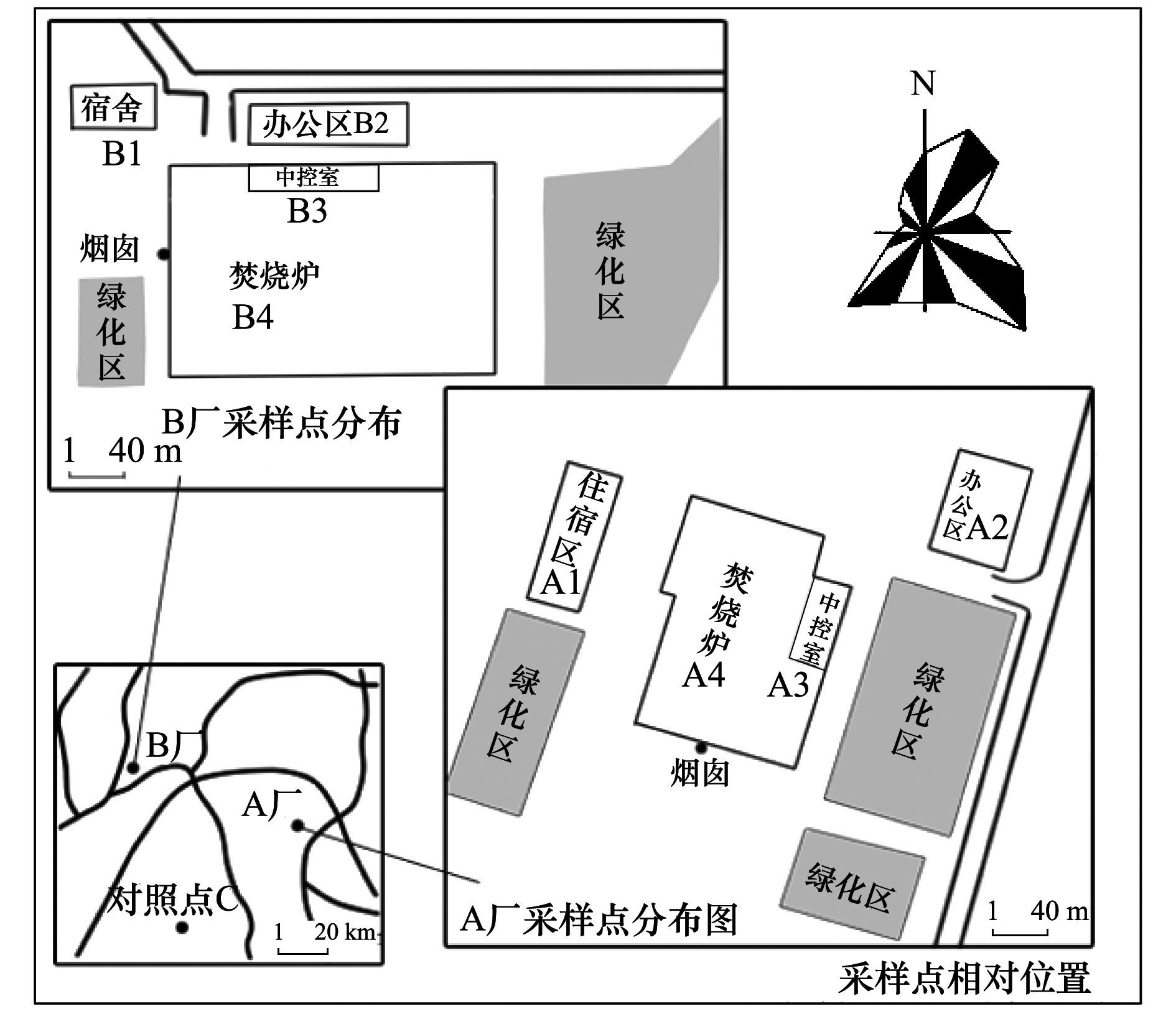
|
图 1 垃圾焚烧厂区域采样点分布示意 Fig. 1 Location of sampling sites in waste incineration plant |
样品采样方法参见HJ 77.2-2008《环境空气和废气二噁英的测定同位素稀释高分辨气相色谱-高分辨质谱法》[16].采样前, GFF在450℃马弗炉里焙烧4 h, 以去除杂质; 聚氨基甲酸酯(polyurethane fibers, PUF)用85℃去离子水洗净、甲醇脱水, 并用二氯甲烷索氏抽提16 h, 用真空干燥器干燥待用.采样过程中用TCR收集样品, 用GFF收集细颗粒物(PM2.5)样品, 用PUF收集气相样品, 各个点位的采样工作同时进行, 每个点连续采集4 d, 流速为250 L·min-1.采样后, 滤膜和PUF置于冷冻室待测.
1.3 前处理样品中PCDD/Fs采用索氏抽提法提取.系统经二氯甲烷预抽提4 h后, 以正己烷与二氯甲烷体积比为1:1的混合溶剂抽提24 h, 加入13C标记的提取内标, 提取液经旋转蒸发浓缩至1~2 mL后通过专利方法净化[17].将洗脱液浓缩并转移至进样瓶, -20℃保存.
1.4 质量控制质量控制包括采样空白、实验室空白和空白加标实验, 空白检出结果均低于方法检出限.实际样品中PCDD/Fs的浓度已扣除空白值.分析过程中, 采样标回收率为70%~100%, 满足HJ 77.2-2008的要求.采样和分析仪器使用前均要进行校正.数据处理过程中, 样品检出限为0.005~0.069 pg·m-3, 低于样品检出限的目标污染物浓度均视作0参与计算, 以算术平均值代表采样点浓度.
2 结果与讨论 2.1 焚烧厂二噁英含量水平对比为研究两垃圾焚烧厂二噁英类物质污染水平, 分别对A、B两厂进行采样分析, 其二噁英污染空间分布见图 2.背景对照区C的二噁英浓度分别为3.97 pg·m-3和13.34 pg·m-3, 平均浓度为8.65 pg·m-3, 低于广州市背景区二噁英浓度值(28.50 pg·m-3)[18], 此背景对照区的二噁英浓度水平不高.

|
图 2 焚烧厂中二噁英浓度空间分布 Fig. 2 Spatial distribution of PCDD/Fs concentration in waste incineration plant |
A厂内环境空气中二噁英浓度范围为1.01~167.03 pg·m-3, 平均为62.06 pg·m-3, 约为背景对照区的7倍; B厂内环境空气的二噁英浓度范围为2.55~118.11 pg·m-3, 平均为47.62 pg·m-3, 是背景对照区的5倍左右; A厂二噁英平均浓度及最大浓度均比B厂高.说明两厂工艺炉型不同, 对二噁英的去除效率不同.两厂的二噁英浓度水平均高于杭州某城市垃圾焚烧厂中二噁英浓度(31.90 pg·m-3)[7]及广东某垃圾焚烧厂中二噁英最高浓度(33.4 pg·m-3)[19], 处于较高水平.
焚烧厂环境空气中毒性当量(以I-TEQ计)浓度如图 3所示.整体来看, 厂区内多数点位的I-TEQ值均超过0.6 pg·m-3(环境空气质量标准). A厂平均I-TEQ值为0.604 pg·m-3, B厂平均I-TEQ值为0.837 pg·m-3.对比可知, 两厂工作场所内的二噁英平均毒性浓度水平远超过如瑞典(0.004~0.055 pg·m-3)[20]、德国(0.043 pg·m-3)[21]和葡萄牙马德拉(0.034 pg·m-3)[22]等低排放量焚烧厂的周边环境空气中PCDD/Fs的毒性含量水平, 本研究中的两个垃圾焚烧厂厂内I-TEQ值位于较高的毒性水平.
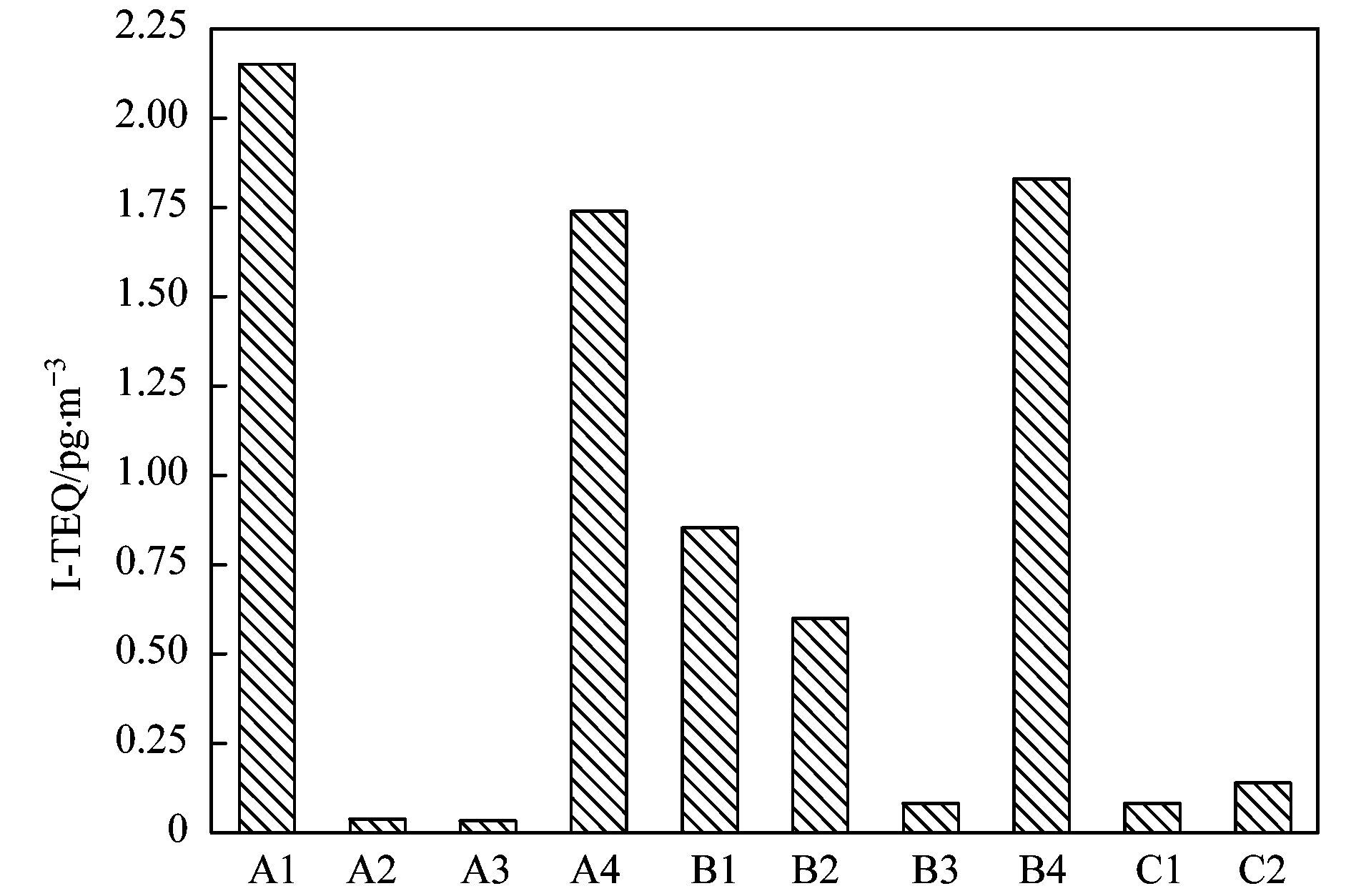
|
图 3 样品中二噁英I-TEQ值 Fig. 3 I-TEQ values of dioxin in samples |
为考察采样点区域二噁英分布特征, 对样品进行主成分(principal component analysis, PCA)分析, 其中以17种2, 3, 7, 8-取代位二噁英的同类物质量浓度所占比例为变量, 用SPSS进行PCA分析得到的4个主成分可解释总变量的88.56%.同时, 为了对采样点环境空气中二噁英来源进行更准确的分析, 引入烹饪烟尘[23](D1~D3)、客车及公交车[24](D4~D5) 和私家车[25](E1~E6) 排放尾气中的二噁英数据代表研究区域其他主要潜在排放源进行PCA分析.
表 2为各变量在4个主成分上的载荷分布.主成分1中PCDFs载荷均较高; 主成分2中, 1, 2, 3, 7, 8, 9-HxCDD、1, 2, 3, 4, 7, 8-HxCDD和1, 2, 3, 6, 7, 8-HxCDD载荷较高; 主成分3中载荷较高的污染物为低氯代的PCDDs; 主成分4中2, 3, 4, 6, 7, 8-HxCDF和OCDF载荷较高.
|
|
表 2 样品PCA结果 Table 2 PCA results of samples |
结合采样点的主成分得分分布(图 4、5)与二噁英类化合物的同系物分布特征(图 6)可知, 在主成分1、2的分布上, 焚烧厂的采样点和其它潜在污染源的主成分得分均较集中, 基本按照污染来源划分; 主成分3、4上的得分分布较交叉, 说明采样点的污染来源多样.同时, 所有采样点二噁英类物质分布都较相似, 均以OCDD和1, 2, 3, 4, 6, 7, 8-HpCDD为主, 且两厂工作场所内的同系物浓度均随氯代数的增加而增加, 与Shih等[26]对这方面的研究结果一致.
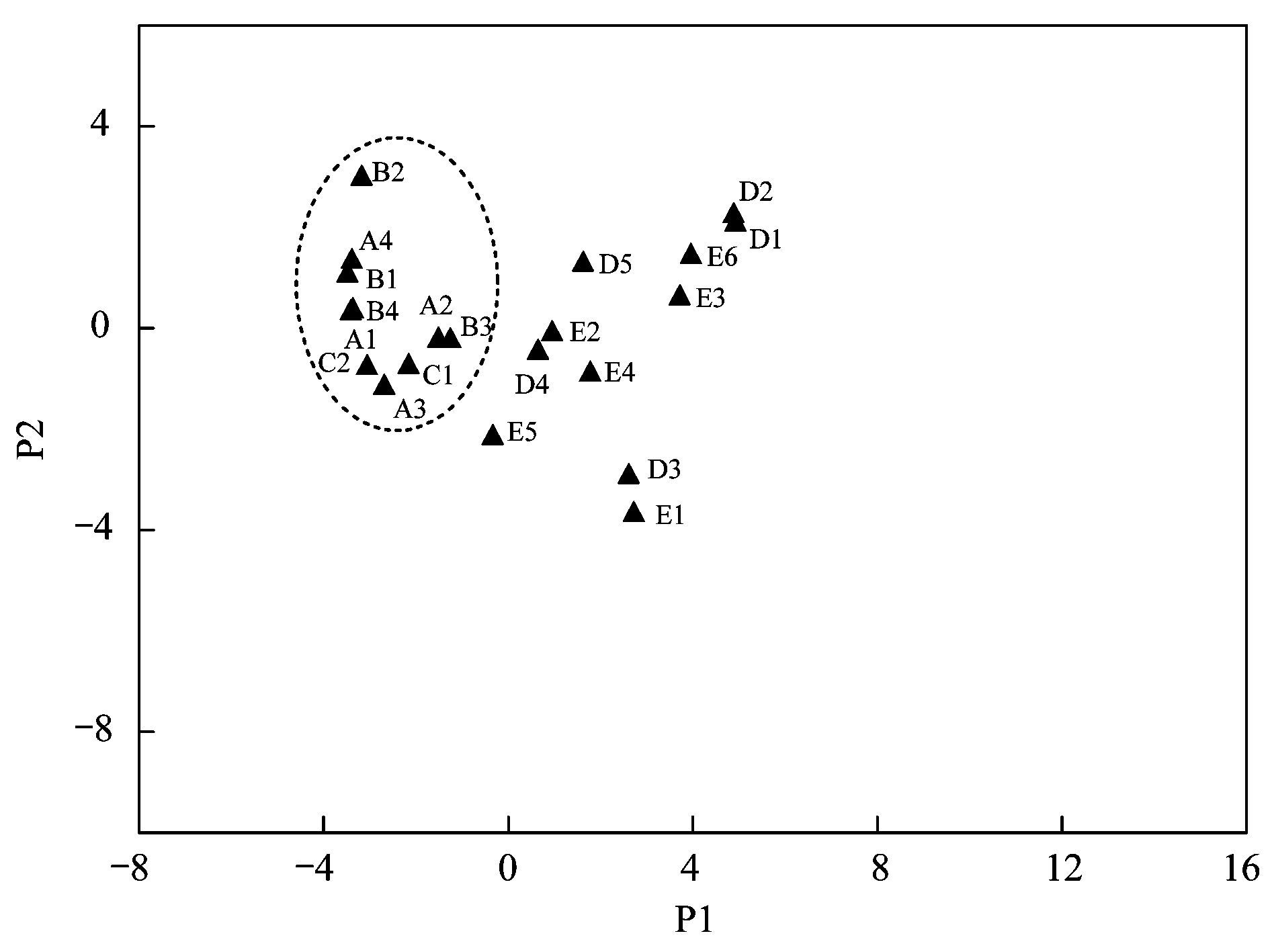
|
图 4 主成分1/2得分 Fig. 4 Component scores of P1/P2 |
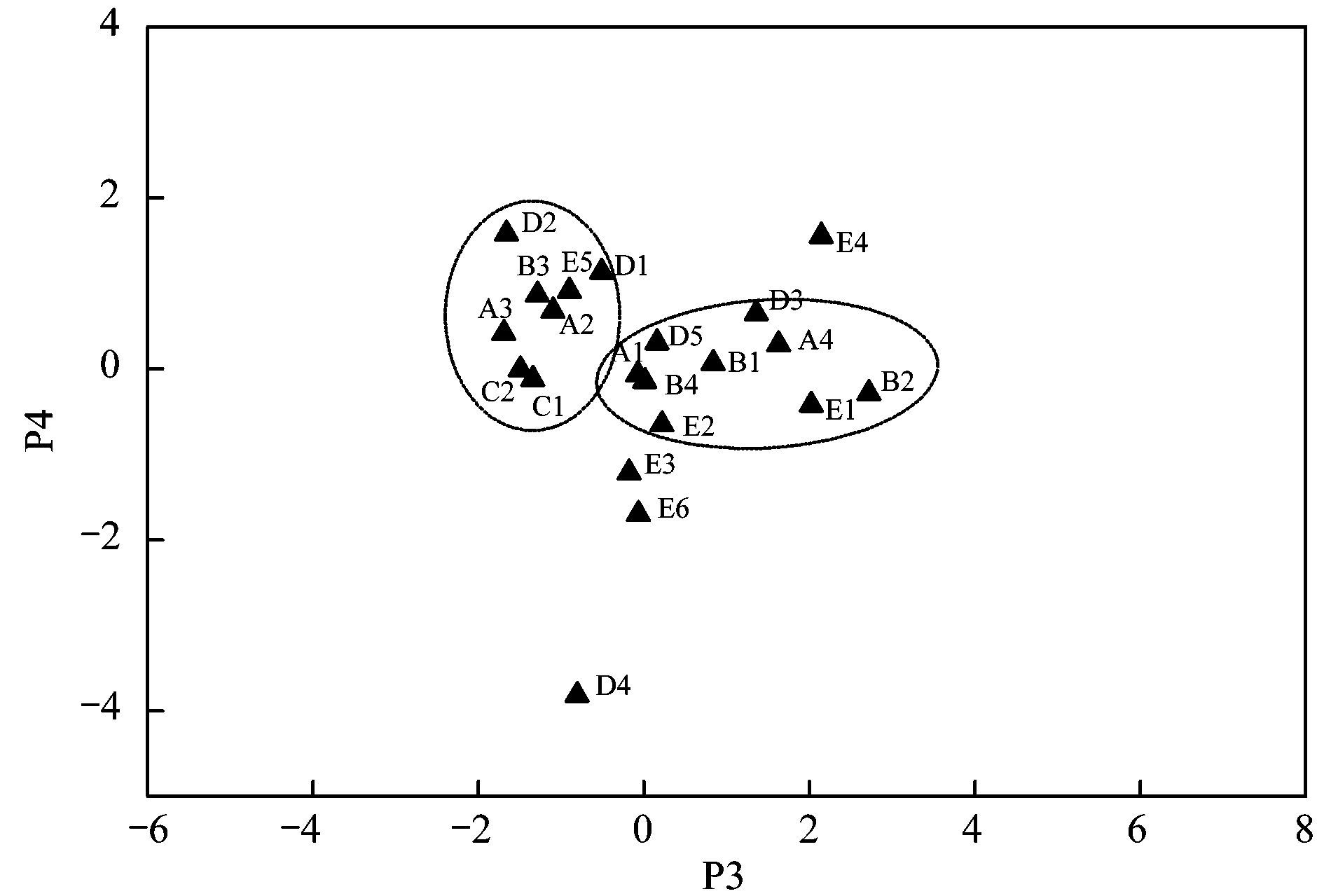
|
图 5 主成分3/4得分 Fig. 5 Component scores of P3/P4 |
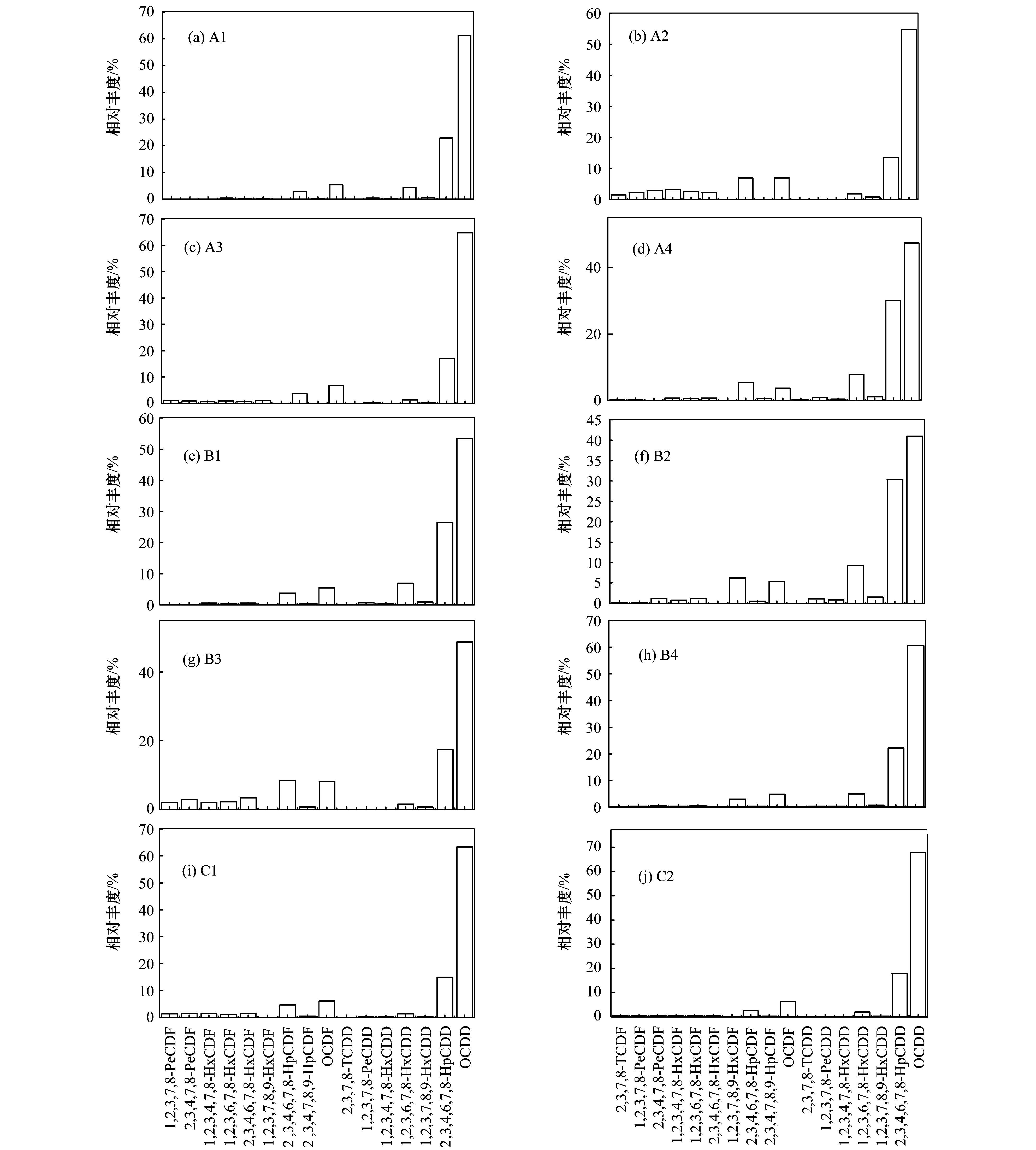
|
图 6 采样点二噁英同系物浓度分布特征 Fig. 6 Congener distribution of PCDD/Fs in sampling sites |
在垃圾焚烧炉类型为炉排炉的情况下, 其排放烟气与焚烧炉飞灰中二噁英污染物均以OCDD为主, 同时在二噁英同系物中, PCDDs同系物含量随着氯代数的增加而增加, PCDFs的同系物浓度基本相同[27, 28].这与本研究中A厂PCDD/Fs指纹特征基本一致, 说明A厂的环境空气受到了该厂焚烧烟气及飞灰的影响.
在流化床焚烧炉类型的处理厂中, 烟气产生的二噁英由PCDFs占主导, 飞灰中的主要贡献物为OCDD、1, 2, 3, 4, 6, 7, 8-HpCDF及1, 2, 3, 4, 6, 7, 8-HpCDD[29].此外, 循环流化床焚烧炉的烟气排放性能好但飞灰产生量大且不易控制[30], 对于离污染源近的厂区环境空气, PM2.5不易扩散, PM2.5附着的低氯代PCDDs同系物对该处的环境空气起主导作用[31].这与本研究中B厂二噁英分布特征大致相似, 故推测B厂的空气可能主要受到焚烧炉飞灰排放的影响.
对照区C1、C2环境空气中的二噁英指纹特征和两厂厂区内的二噁英指纹特征相似.除焚烧源外, 机动车排放产生的二噁英类化合物里也主要含有大量的OCDD[24], 因此C1和C2是否受到当地焚烧厂的影响有待深入研究.
3 厂区工人二噁英呼吸暴露风险评估二噁英类化合物可以通过呼吸道、消化道和皮肤吸收.本研究只考虑人体经呼吸途径摄入的二噁英类化合物含量, 采用Nouwen等[5]的研究评估公式来计算个体二噁英类化合物外暴露量, 计算公式见式(1).

|
(1) |
式中, Inh指呼吸暴露剂量[pg·(kg·d)-1]; Vr指不同劳动强度下的肺通气量(L·min-1), 不同劳动强度的肺通气量参考liu等[32]的报道结果; Cair指环境空气中二噁英的平均I-TEQ值(pg·m-3); fr指肺泡阻留率, 0.75;t指工人平均工作时间, 10 h·d-1; BW指体重, 其中男性:70 kg, 女性:60 kg.
根据以上公式计算出的结果如表 3所示.可以得出在低污染的空间如A2、A3和B3内, 男性和女性的个体二噁英呼吸暴露水平相当且很低.其他区域里的二噁英呼吸暴露水平在相同条件下随着劳动强度的变大而增大, 且女性的暴露水平普遍高于男性的暴露水平.
A厂内二噁英个体呼吸暴露水平为0.01~1.10 pg·(kg·d)-1, 平均0.34 pg·(kg·d)-1. B厂的二噁英个体呼吸暴露量为0.02~0.94 pg·(kg·d)-1, 平均值为0.29 pg·(kg·d)-1, 略低于A厂的个体呼吸暴露量. A、B两厂的平均呼吸暴露水平和韩国某大城市地区人群的呼吸暴露水平[0.11 pg·(kg·d)-1][33]大致相当, 但远远高于比利时[0.006 pg·(kg·d)-1][5]、西班牙[0.046 pg·(kg·d)-1][6]等国焚烧厂周边的暴露水平.
|
|
表 3 二噁英呼吸暴露量/pg·(kg·d)-1 Table 3 Dose of dioxin inhalation exposure/pg·(kg·d)-1 |
4 结论
(1) 两厂区内多数点位I-TEQ值均超过0.6 pg·m-3(环境空气质量标准).焚烧厂A、B环境空气中二噁英I-TEQ均值分别为0.604 pg·m-3和0.837 pg·m-3, 两厂厂内I-TEQ值均处于较高毒性水平.
(2) 焚烧厂区域内的所有采样点的二噁英类物质分布都较相似, 均以OCDD和1, 2, 3, 4, 6, 7, 8-HpCDD为主.
(3) A、B厂内二噁英个体平均呼吸暴露量分别为0.34 pg·(kg·d)-1和0.29 pg·(kg·d)-1, 远高于其他焚烧厂周边的暴露水平, 且女性的暴露水平普遍高于男性的暴露水平.
致谢: 本研究在采样过程中得到了环境保护部华南环境科学研究所痕量有机污染物课题组的帮助, 在此表示感谢.| [1] | Huwe J K. Dioxins in food:a modern agricultural perspective[J]. Journal of Agricultural and Food Chemistry, 2002, 50(7): 1739–1750. DOI: 10.1021/jf011265f |
| [2] | Schecter A, Birnbaum L, Ryan J J, et al. Dioxins:an overview[J]. Environmental Research, 2006, 101(3): 419–428. DOI: 10.1016/j.envres.2005.12.003 |
| [3] | Listed N. Polychlorinated dibenzo-para-dioxins[J]. Iarc Monographs on the Evaluation of Carcinogenic Risks to Humans, 1997, 69(1): 307–316. |
| [4] | 朱广钦. 生活垃圾焚烧行业二恶英的产生与控制方法[J]. 现代农业科技, 2015(10): 216–217. Zhu G Q. Formation and control methods for PCDD/Fs in the industry of domestic waste incineration[J]. Modern Agricultural Science and Technology, 2015(10): 216–217. DOI: 10.3969/j.issn.1007-5739.2015.10.130 |
| [5] | Nouwen J, Cornelis C, De Fré R, et al. Health risk assessment of dioxin emissions from municipal waste incinerators:the Neerlandquarter (Wilrijk, Belgium)[J]. Chemosphere, 2001, 43(4-7): 909–923. DOI: 10.1016/S0045-6535(00)00504-X |
| [6] | Domingo J L, Agramunt M C, Nadal M, et al. Health risk assessment of PCDD/PCDF exposure for the population living in the vicinity of a municipal waste incinerator[J]. Archives of Environmental Contamination and Toxicology, 2002, 43(4): 461–465. DOI: 10.1007/s00244-002-1280-6 |
| [7] | Lee S, Choi S D, Jin G Z, et al. Assessment of PCDD/F risk after implementation of emission reduction at a MSWI[J]. Chemosphere, 2007, 68(5): 856–863. DOI: 10.1016/j.chemosphere.2007.02.036 |
| [8] | 孟紫强. 现代环境毒理学[M]. 北京: 中国环境科学出版社, 2015: 175-187. Meng Z Q. Modern environmental toxicology[M]. Beijing: China Environmental Science Press, 2015: 175-187. |
| [9] | 金立新, 侯青叶, 杨忠芳, 等. 四川德阳地区农田生态系统重金属健康风险评价[J]. 地学前缘, 2008, 15(5): 47–56. Jin L X, Hou Q Y, Yang Z F, et al. Environmental health risk assessment of heavy metals in argo-ecosystems of Deyang district, Sichuan Province[J]. Earth Science Frontiers, 2008, 15(5): 47–56. |
| [10] | Xu M X, Yan J H, Lu S Y, et al. Concentrations, profiles, and sources of atmospheric PCDD/Fs near a municipal solid waste incinerator in eastern China[J]. Environmental Science & Technology, 2009, 43(4): 1023–1029. |
| [11] | 杜国勇, 苏原, 任明忠, 等. 气象因素对广州市大气中二(噁)英污染特征的影响[J]. 环境科学, 2014, 35(8): 2857–2863. Du G Y, Su Y, Ren M Z, et al. Effect of meteorological factors on characteristics of PCDD/F pollution in Guangzhou[J]. Environmental Science, 2014, 35(8): 2857–2863. |
| [12] | 李敏, 王超, 倪明江, 等. 医疗废物焚烧厂二(噁)英排放对周边土壤的影响(2007-2014年)[J]. 环境科学学报, 2016, 36(10): 3804–3809. Li M, Wang C, Ni M J, et al. Hazardous impact of PCDD/Fs emissions from the MWI on soil during 2007-2014[J]. Acta Scientiae Circumstantiae, 2016, 36(10): 3804–3809. |
| [13] | 刘永林, 孙启民, 钟明洋, 等. 重庆市主城区PM2.5时空分布特征[J]. 环境科学, 2016, 37(4): 1219–1229. Liu Y L, Sun Q M, Zhong M Y, et al. Temporal and spatial distribution characteristics of PM2.5 in Chongqing urban areas[J]. Environmental Science, 2016, 37(4): 1219–1229. |
| [14] | 林海涛, 李琦路, 张干, 等. 中国8个城市大气多溴联苯醚的污染特征及人体暴露水平[J]. 环境科学, 2016, 37(1): 10–15. Lin H T, Li Q L, Zhang G, et al. Atmospheric polybrominated diphenyl ethers in eight cities of China:pollution characteristics and human exposure[J]. Environmental Science, 2016, 37(1): 10–15. |
| [15] | Ni Y W, Zhang H J, Fan S, et al. Emissions of PCDD/Fs from municipal solid waste incinerators in China[J]. Chemosphere, 2009, 75(9): 1153–1158. DOI: 10.1016/j.chemosphere.2009.02.051 |
| [16] | HJ 77. 2-2008环境空气和废气二(噁)英类的测定同位素稀释高分辨气相色谱-高分辨质谱法[S]. |
| [17] | 张漫雯, 张素坤, 李艳静, 等. 检测沉积物中多氯代二苯并对二(噁)英和多氯代二苯并呋喃(PCDD/Fs)的前处理方法优化[J]. 环境化学, 2011, 30(3): 723–724. |
| [18] | 苏青, 任明忠, 张素坤, 等. 广州市不同功能区大气二(噁)英含量和分布特征研究[J]. 环境科学学报, 2012, 32(11): 2704–2711. Su Q, Ren M Z, Zhang S K, et al. The distribution characteristics of PCDD/Fs in the atmosphere at different areas of Guangzhou city[J]. Acta Scientiae Circumstantiae, 2012, 32(11): 2704–2711. |
| [19] | 苏珊珊. 二(噁)英环境多介质分布、焚烧释放及减量控制研究[D]. 武汉: 华中科技大学, 2012. 35-40. Su S S. Study of distribution in the environmental multimedia, burning release and reduction control of dioxins[D]. Wuhan:Huazhong University of Science and Technology, 2012. 35-40. |
| [20] | Tysklind M, Faengmark I, Marklund S, et al. Atmospheric transport and transformation of polychlorinated dibenzo-p-dioxins and dibenzofurans[J]. Environmental Science & Technology, 1993, 27(10): 2190–2197. |
| [21] | Holoubek I, Ko Dč an A, Petrik J, et al. Project tocoen the fate of selected organic compounds in the environment part Ⅶ. PCBs, PCDDs and PCDFs in ambient air in Czechoslovakia-1990[J]. Chemosphere, 1991, 23(8-10): 1345–1348. DOI: 10.1016/0045-6535(91)90158-A |
| [22] | Coutinho M, Pereira M, Borrego C. Monitoring of ambient air PCDD/F levels in Portugal[J]. Chemosphere, 2007, 67(9): 1715–1721. DOI: 10.1016/j.chemosphere.2006.05.084 |
| [23] | 孙俊玲. 北京市大气环境中二(噁)英和多氯联苯的污染特征和气-粒分配行为研究[D]. 北京: 中国地质大学, 2009. 91-95. Sun J L. Atmospheric pollution profiles, gas-particle partitioning of polychlorinated dibenzo-p-dioxins and dibenzo-furans (PCDD/FS) and polychlorinated biphenyls (PCBS) in Beijing[D]. Beijing:China University of Geosciences, 2009. 91-95. |
| [24] | 余莉萍. 广州大气中二(噁)英的浓度分布和几种典型二(噁)英排放源的初步研究[D]. 广州: 中国科学院广州地球化学研究所, 2007. 87-89. Yu L P. Preliminary study on levels of PCDD/Fs in atmosphere of Guangzhou and typical emission sources of PCDD/Fs, China[D]. Guangzhou:Guangzhou Institute of Geochemistry, Chinese Academy of Sciences, 2007. 87-89. |
| [25] | 邓芸芸. 广州市机动车来源多环芳烃与二(噁)英的污染特征研究[D]. 广州: 中国科学院广州地球化学研究所, 2007. 71-85. Deng Y Y. Traffic-source polycyclic aromatic hydrocarbons (PAHs) and polychlorinated dibenzo-p-dioxin (PCDD) and polychlorinated dibenzofuran (PCDF) in Guangzhou[D]. Guangzhou:Guangzhou Institute of Geochemistry, Chinese Academy of Sciences, 2007. 71-85. |
| [26] | Shih S I, Wang Y F, Chang J E, et al. Comparisons of levels of polychlorinated dibenzo-p-dioxins/dibenzofurans in the surrounding environment and workplace of two municipal solid waste incinerators[J]. Journal of Hazardous Materials, 2006, 137(3): 1817–1830. DOI: 10.1016/j.jhazmat.2006.05.022 |
| [27] | 陈彤. 城市生活垃圾焚烧过程中二(噁)英的形成机理及控制技术研究[D]. 杭州: 浙江大学, 2006. 132-148. Chen T. Mechanism and experimental study on PCDD/Fs formation and control during municipal solid wastes incineration[D]. Hangzhou:Zhejiang University, 2006. 132-148. |
| [28] | 李艳静, 张素坤, 冯桂贤, 等. 两种典型生活垃圾焚烧炉烟气中二相态分布特征[J]. 中国环境科学, 2011, 31(10): 1632–1636. Li Y J, Zhang S K, Feng G X, et al. Multiphase distribution characteristics of PCDDs/PCDFs from two typical municipal waste incinerators[J]. China Environmental Science, 2011, 31(10): 1632–1636. |
| [29] | 金宜英, 田洪海, 聂永丰, 等. 3个城市生活垃圾焚烧炉飞灰中二(噁)英类分析[J]. 环境科学, 2003, 24(3): 21–25. Jin Y Y, Tian H H, Nie Y F, et al. Dioxins contents in fly ash of MSW incinerator in three city[J]. Environmental Science, 2003, 24(3): 21–25. |
| [30] | 别如山, 王国庆. 采用循环流化床技术焚烧城市生活垃圾[J]. 环境污染治理技术与设备, 2003, 4(11): 79–82. Bie R S, Wang G Q. Application of CFB combustion technology to incineration of municipal solid waste[J]. Techniques and Equipment for Environmental Pollution Control, 2003, 4(11): 79–82. |
| [31] | 徐梦侠. 城市生活垃圾焚烧厂二(噁)英排放的环境影响研究[D]. 杭州: 浙江大学, 2009. 93-109. Xu M X. Environmental impact study on PCDD/F emissions from the municipal solid waste incineration plant[D]. Hangzhou:Zhejiang University, 2009. 93-109. |
| [32] | Liu S F, Qi T S, Zhang D, et al. Research about the relationships among labor load, heart rate, oxygen consumption and pulmonary ventilation volume of vegetable growers[J]. China Occupational Medicine, 1990, 17(119): 207–209. |
| [33] | Park J S, Kim J G. Regional measurements of PCDD/PCDF concentrations in Korean atmosphere and comparison with gas-particle partitioning models[J]. Chemosphere, 2002, 49(7): 755–764. DOI: 10.1016/S0045-6535(02)00375-2 |
 2017, Vol. 38
2017, Vol. 38

